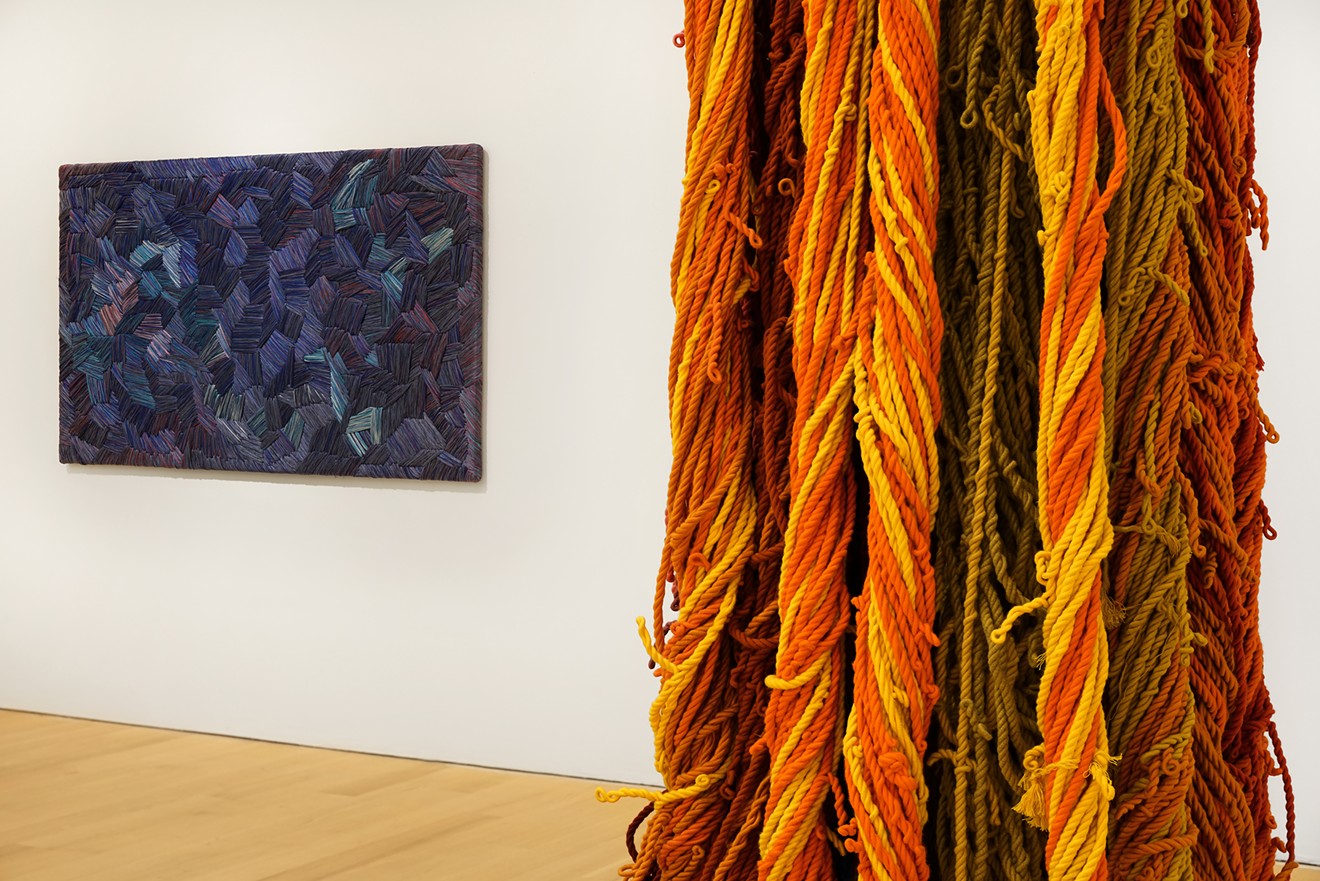"I like to broaden the audience range here," she reflects, "and the secret is: benches."
The point of the benches isn't just to extend the time a person spends in front of one of Hicks' works, on display in "Campo Abierto (Open Field)" at the Bass. Sitting at a safe distance from one of her fiber sculptures, you might get a sense of their architectural scope, the interplay of vibrant colors, and the movement of loose thread or draping cloth. However, you'd lose the details: letters and numbers stitched into a repurposed nurse's uniform, an unexpected swatch of shiny vinyl fabric, delicate-seeming metal twisted around hair-like string. It feels necessary to approach her works from both perspectives.
Hicks is quick to correct: "From all perspectives, not from both. 'Both' means 'either/or.' From all perspectives. When you’re 4 years old, when you’re 40, when you’re 80, when you’re 90. Or if you’re in a wheelchair or if you’re sitting on a bench because you can’t walk through an immense show, but you’re dying to see the show.
"I’m trying to make the show accessible. To me it’s very important, and I always do that."
It's clear that accessibility isn't just a paltry gesture for Hicks. Though the most arresting pieces in "Campo Abierto" are large and not immediately representational, there's a basic resonance with the everyday that allows for a range of delightful associations. There's the material itself — the stuff of clothes, carpets, and even tires — but also the range of texture, scale, and technique that opens each object up for exploration.
"It’s more contemplative. You can think longer and you’re drawn in, and when you leave, it stays with you longer," she says. "You’ll wake up a day or two later, and you’ll happen to see someone sitting in front of you wearing something, and you’ll say, ‘That reminds me of that exhibition I saw the other day.’ And you’ll smile because you discovered something. So there’s a slight bit of serious humor involved."

Sheila Hicks' Varmayana (The Palace of Shining Light) (2018)
Photo by Zachary Balber, courtesy of the Bass
"At this point, I’m going to try to hold the bar as high as possible," Hicks asserts. "And for young people who are just discovering our world and the world of art and the world of culture, I’m going to try to hold the bar at their height, but encourage them to jump each day a little higher."
This desire to elevate is reflected not only in the overarching themes of Hicks' show, but in the incredible level of craft exhibited in each piece. Large woven panels, hanging tapestries, columns of cascading colors are all executed with exquisite detail.
"My wager or my bet is that they’ll walk into the show and say, ‘Hmm…what’s this about?’ and they’re going to creep slowly into the show and become intimately involved," Hicks says. "Not just because of the benches, but because of the color, obviously, the tactility, the intimacy of the structure of these things. They are not made with a broad brush. They’re made by loving hands, and you can sense that, and you can see the patience involved."

Sheila Hicks' Escalade Beyond Chromatic Lands (2016-17)
Photo by Zachary Balber, courtesy of the Bass
"This material" — Hicks touches her scarf — "it’s what we call in French a passe-partout." She explains this before sharing that her first inspiration to switch to fibers came from archaeological photographs of mummy wrappings, bodies and treasures alike encased in fabric for centuries. "You know when you’re a locksmith and you have to make keys for people’s doors and there are certain keys that are master keys? How do they make that key that opens all the doors? That’s what I say this material and this methodology of working [do]. It’s a passe-partout."
Accessibility, humor, sensuality, history — the longer you sit with Hicks' work, the more layers reveal themselves. And while the spaces where "Campo Abierto" is exhibited aren't massive, the work can invite hours of contemplation.
If that sounds daunting, don't worry — there will be benches.
"Sheila Hicks: Campo Abierto (Open Field)." Through September 29 at The Bass Museum of Art, 2100 Collins Ave., Miami Beach; 305-673-7530; thebass.org. Wednesday through Sunday 10 a.m. to 5 p.m. Admission is $10.











